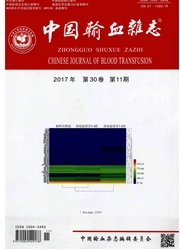

 中文摘要:
中文摘要:
目的了解青海高原地区不同民族围产期孕妇RhD(-)及不规则抗体特异性的分布规律与临床意义。方法对2010年1月-2014年12月期间在本院产科住院的汉族43836名、藏族3487名和回族2626名围产期孕妇,作RhD血型及不规则抗体检测,并对检测结果作统计分析。结果在49949名孕妇中RhD(-)总检出率为6.99‰(349/49949),其中汉族孕妇RhD(-)检出率5.43%D(238/43836)、藏族孕妇RhD(-)检出率为9.75%。(34/3487)、回族孕妇RhD(-)检出率为29.32%0(77/2626),藏、回族RhD(-)检出率明显高于汉族(P〈0.05),而回族又明显高于藏族(P〈0.01)。13581名孕妇不规则抗体总检出率为0.42%(57/13581),其中汉族0.33%(35/10688)、藏族0.38%(7/1846)、回族1.07%(15/1407),回族不规则抗体检出率明显高于与汉族、藏族(P〈0.05);汉族孕妇的不规则抗体检出率依次为抗-E0.08%(9/10688)、抗-M0.06%(7/10688)、抗-D0.05%(5/10688)、抗.e0.05%(5/10688)、抗-c0.04%(4/10688)、抗-Le^a 0.02%(3/10688)、抗-P10.01%(1/10688)和抗-Le^b 0.01%(1/10688);藏族依次为抗.E0.11%(2/1846)、抗-M0.1t%(2/1846)、抗-D0.05%(1/1846)、抗-c0.05%(1/1846)、抗.c0.05%(1/1846),回族依次为抗-E0.28%(4/1407)、抗-M0.14%(2/1407)、抗-D0.21%(3/1407)、抗-e0.14%(2/1407)、抗-c0.08%(1/1407)、抗-Le^a 0.14%(2/1407)和抗-P10.08%(1/1407)。结论青海高原汉、藏、回族围产期孕妇中RhD(-)及不规则抗体检出率藏、回族高于汉族,以回族最高。
 英文摘要:
英文摘要:
Objective To research the distribution and its clinical significance of RhD ( - ) blood group and irregular antibodies among the Han, Tibetan and Hui ethnic groups in plateau section in Qinghai Plateau. Methods The RhD blood group and irregular antibody of perinatal stage pregnant women of Han, Zang (Tibetan) and Hui ethnic origins from Jan 1 st, 2010 to Dec 31st, 2014 were studied. The results were analyzed statistically. Results The total positive rate of RhD-negative blood group in pregnant women was 6. 99%0 ( 349/49 949) In 49 949 cases. The positive rate of RhD-negative blood group in pregnant women of Han, Tibetan and Hui origins was 5.43%0(238/43 836), 9. 75%0(34/3 487), and 29. 32%0 (77/2 626), respectively. Compared with Han people, the positive rate in Tibetan and Hui had statistic difference ( P 〈 0. 05 ). There was significantly difference between Tibetan and Hui nationality ( P 〈 0. 01 ). The rate of irregular antibody detection in 13 581 pregnant women was 0.42% (57/13 581 ). The rates of irregular antibody detection in Han, Tibetan and Hui were 0. 33% (35/10 688), 0. 38% (7/1 846), and 1.07 percent ( 15/1 407), respectively. The rate of irregular anti- bodies in Hui was higher than in Han and Zang people ( P 〈 0.05 ). The rate of irregular antibody detection in Han pregnant women were anti-E 0. 08% (9/10 688), anti-M 0. 06% (7/10 688), anti-D 0. 05% (5/10 688), anti-e 0.05% (5/10 688), anti-c 0. 04% (4/10 688), anti-Le^a 0. 02% (3/10 688), anti-P 10.01% (1/10 688), anti-Leb 0. 01% ( 1/10 688). The rates in Zang were anti-E 0. 11% (2/1 846), anti-M 0. 11% (2/1 846), anti-D 0. 05% ( 1/1 846), anti-e 0. 05% ( 1/1 846), anti-e 0.05% ( 1/1 846). The rates in Hui were anti-E 0. 28% (4/1 407), anti-M 0. 14% (2/1 407), anti-D 0. 21% (3/1 407), anti-e 0. 14% (2/1 407), anti-c 0. 08% ( 1/1 407), anti-Lea 0. 14% (2/1 407), an-ti-P1 0.08% (1/1 407). Conclusion The rate of Rh
 同期刊论文项目
同期刊论文项目
 同项目期刊论文
同项目期刊论文
 期刊信息
期刊信息
